
Some fruit on display at last week’s foraging class in Largo: Gopher apples, tallow plums, saw palmettto berries. Photo by Green Deane

Monarda punctata, Horsemint, Beebalm. Photo by Green Deane
We’ve mentioned it a few times in recent newsletters but it bares repeating: Horsemint — right — is in season and very easy to find now. Look in grassy sandy places or along paths in always dry areas. The pleasant side of the plant is that it smells nice and makes a Thyme-like spice. The naughty side of the species is that it contains Thymol which is a relaxant. Made into a tea it calms you down. How much it calms you down depends on how much you use and your personal response to it. You can also suspend some in your house as an air freshener. You can read about Horsemint here.
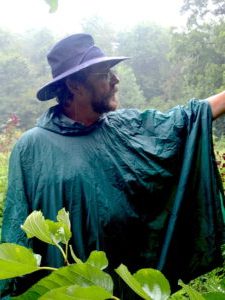
Classes are held rain or shine (but not during hurricanes.)
Foraging Classes: Sticking to the west coast of Florida this coming weekend, as the weather might accommodate. Ft. Desoto has many salt-tolerant edibles, persimmon trees, and poison Ivy. Bayshore Park has the same salt-tolerant edibles and many ignored fruit trees such as champagne mangoes, Java plums and Star Fruit.
Saturday, September 7th, Ft. Desoto Park, 3500 Pinellas Bayway S. St. Petersburg Fl 33715. There is a small entrance fee to the park. Meet at the Bay Pier parking lot.(The one with a dog park and ferry to Egmont Key.) 9 a.m. to noon.
Sunday September 8, Bayshore Live Oak Park, Bayshore Drive. Port Charlotte 9 a.m. to noon, meet at the parking lot at Bayshore Drive and Ganyard Street.
For more information on these classes, to prepay or sign up go here. The cost is $30 per adult (the class is usually three hours long and examines five-dozen or so species.) If cost is a hardship email me at: GreenDeane@gmail.com.
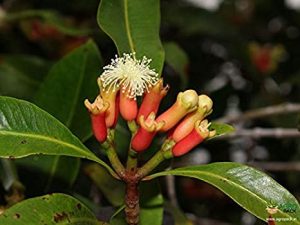
Cloves are dried flower buds.
Recnetly we mentioned here that the Syzygiums were fruiting. That mostly included S. cumini also known as the Java Plum and Jambul. I’m making wine out of that. There are a few Jambuls in Orlando and certainly dozens in West Palm Beach. I know they also grow well in Sarasota and Port Charlotte where I think they are naturalized. Both Syzygium jambos and Syzygium samaragense are called the Rose Apple and Java Apple (and many other names as well.) There also is a Syzygium in your kitchen is S. aromaticum. You know the dried flower buds as “cloves.” As the species have been in foraging news lately I decided to bite the proverbial bullet and write a second article on the genus, or at least the latest one. You can read that article here and you can read about the Jambul here.
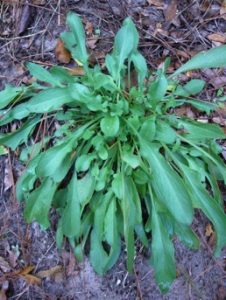
The leaves of Heartwing sorrel resemble a knife hilt. Photo by Green Deane
In some parts of the country fall is upon the landscape and final harvesting is underway before plants shut down for the winter. When I was a boy in Maine this meant scrumping apples and concord grapes. Locally our winter foraging season is just starting and while it is still warm one edible to start looking for is the Heartwing Sorrel, noticed in Gainesville recently. This tart Rumex is closely related to Sheep’s Sorrel — sometimes is mistakenly called that — and is used the same way, usually as an addition to salads. This time of year there will be a plant here and a plant there. Look along grassy trails, pastures or fields particularly in northern areas. In a few months locally it can cover an entire field with a ruddy pink blanket of ripening seeds. (It’s commercial relative is buckwheat.) To read more about the Heartwing Sorrel go here
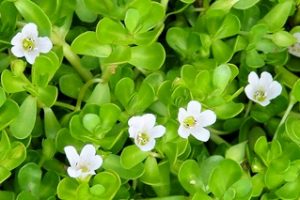
Bacopa monnieri blossoms can have four or five petals. Phgoto by Green Deane
There are six Bacopa in Florida but we are interested mainly in one, Water Hyssop, Bacopa monnieri. It’s a very bitter herb that looks like dwarf purslane except it’s all green. Water Hyssop has four- or five-petaled blossoms. They can be off-white, light blue or even light pink. You find the plant growing in damp or inundated areas. It is the only Bacopa with one line on the back (or top) of its leaf. What’s interesting about Water Hyssop is that two different studies show it can increase memory function. The plant causes a gene to upregulate or “express itself.” This means the DNA in the gene can stretch, literally like a spring losing tension. This in turn causes the gene to make a protein. That protein causes the hippocampus to make new memory cells. It takes three months for the difference to be noticed. You can read about the Bacopas here and here.

Green Deane Forum
Tired of Facebook and want to identify a plant? The Green Dean Forum is up and running again. Have you come to dislike Facebook, then join us on the forum. Perhaps you’re looking for a foraging reference? You might have a UFO, an Unidentified Flowering Object, you want identified. On the Green Deane Forum we — including Green Deane and others from around the world — chat about foraging all year. And it’s not just about warm-weather plants or just North American flora. Many nations share common weeds so there’s a lot to talk. There’s also more than weeds. The reference section has information for foraging around the world. There are also articles on food preservation, and forgotten skills from

You get the USB, not the key.
172-video USB would be a good end of spring present and is now $99. My nine-DVD set of 135 videos has been phased out. The USB videos are the same videos I have on You Tube. Some people like to have their own copy. Most of the 172 USB videos have to be copied to your computer to play. If you want to order the USB go to the DVD/USB order button on the top right of this page. That will take you to an order form.
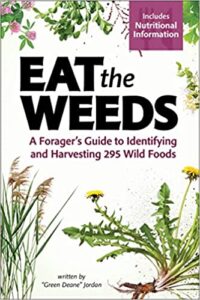
Now in second printing.
EAT THE WEEDS, the book, 274 plants, 367 pages, index, nutrition charts and color photos. It’s available in many locations including Amazon. Most of the entries include a nutritional profile. It can also be ordered through AdventureKeen Publishing.
This is weekly newsletter #610. If you want to subscribe to this free newsletter you can find the sign-up form in the menu at the top of the page.
To donate to the Green Deane Newsletter click here.
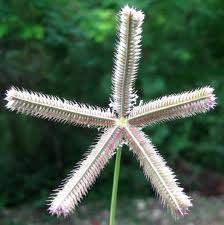 Crowfoot Grass, which is starting to ripen now, is not a native North American grass. It’s from Africa where the species is used to make unleavened bread and a frothy beer. While crowfoot grass is easy to harvest — when ripe — the grains are tiny, eye of a needle size. You can collect about two quarts an hour — making them calorie positive — and they can grow in large colonies making harvesting easy. Usually you collect the grains while sitting and using window screen plastic as a strainer. The grains have a small amount of cyanide in them but drying and cooking drives that off. Though minute botanically they are a mouthful: Dactyloctenium aegyptium. That means ‘little comb fingers from Egypt.’ You can find Crowfoot Grass from Maine to California skipping the upper northwest side of the country.
Crowfoot Grass, which is starting to ripen now, is not a native North American grass. It’s from Africa where the species is used to make unleavened bread and a frothy beer. While crowfoot grass is easy to harvest — when ripe — the grains are tiny, eye of a needle size. You can collect about two quarts an hour — making them calorie positive — and they can grow in large colonies making harvesting easy. Usually you collect the grains while sitting and using window screen plastic as a strainer. The grains have a small amount of cyanide in them but drying and cooking drives that off. Though minute botanically they are a mouthful: Dactyloctenium aegyptium. That means ‘little comb fingers from Egypt.’ You can find Crowfoot Grass from Maine to California skipping the upper northwest side of the country.

The nose doesn’t always know.
The aroma of a wild food is the most flexible of all descriptions. This is for two reasons: Noses differ and plants differ. Taste is also quite flexible but aroma variations beat taste out. When you read in a foraging guide, or even in my articles, that a plant smells like such-and-such know that the description is quite subjective. There are several local species that elicit different descriptions even when noses are whiffing the same sample. One low-growing fruit — the Gopher Apple — has been described as smelling like pink bubble gum, a new plastic shower curtain, or no aroma at all. The smelly spice Epazote ranges in opinions from citrusy to floor varnish to industrial cleaner. Even among non-edibles the olfactory estimations can vary such as with the toxic Laurel Cherry. Some think its cyanide smells like almonds, other think they smell maraschino cherries, some can’t smell the cyanide at all. In guide books a reported aroma is just that, a guide. It is not always for certain by any means. There’s room for aromatic latitude.

